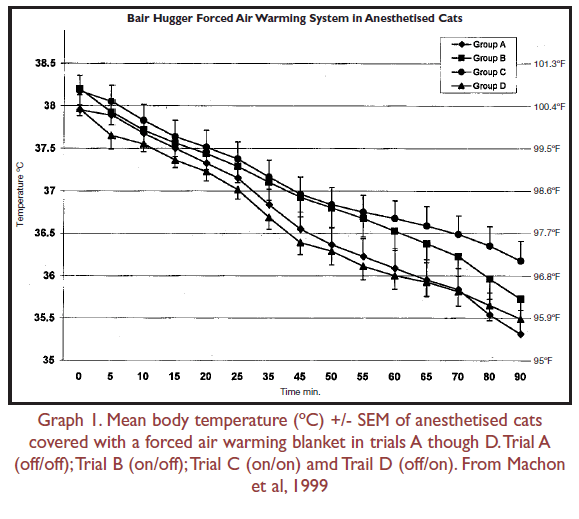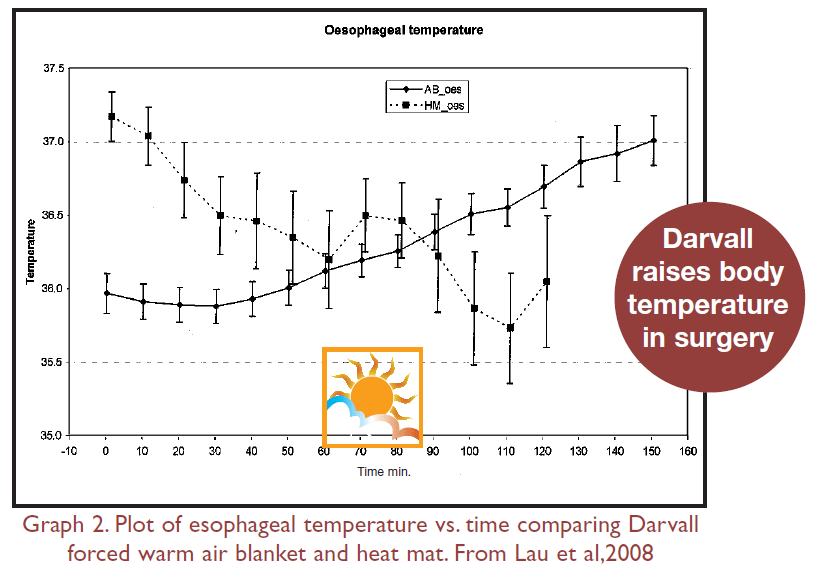Aug 7, 2018, 3:41 PM

Hypothermia (body temperature below 35ºC[95ºF]) has been shown to occur in up to 80% of anesthetized cats and dogs by the end of anesthesia and surgery.
Causes of this problem include small body size relative to body surface area, vasodilation and lack of shivering during anesthesia, breathing cold, dry anaesthetic gases from non-rebreathing systems as well as heat loss during surgery from open body cavities1,2. Most warming devices used on anesthetised animals including electric under blankets or over blankets, warm circulating water under blankets, infra red heating lights and some high flow forced warm air blanket systems designed for human beings are unable to raise the body temperature of hypothermic dogs and cats during surgery (3,4) (Graph 1).

Surface contact alone such as from electric heat blankets seems unable to transfer sufficient heat to raise body temperature (Graph 2) and many of these devices have burnt animals.
In the early 1990 s forced warm air heating was developed for human beings using air filled blankets with 1 to 2 mm punched holes, allowing air to flow onto the patient contact surface (Bair Hugger Patient Warming System, Augustine Medical). When placed over patients recovering from anesthesia they were shown to prevent further heat loss and potentially re-warm patients (2,5)
However these human forced warm air systems have been shown to be effective ONLY as part of the re-warming process mostly when humans are recovering from anesthesia. At this time patients can shiver, have a rise in cardiac function (both causing metabolic heat generation) and return of vaso-motor function. It is also interesting to note that warm air blankets with 1 to 2 mm punched holes for air flow have been shown to be variably effective or ineffective in raising the body temperature of hypothermic human beings during major abdominal surgery(6). In human surgery use of forced warm air heating does not alter the incidence of wound infections and is associated with a decrease in the presence of environmental hair and bacterial contamination.
In anesthetised cats and dogs forced warm air heating systems incorporating blankets with 1 to 2 mm punched holes for air flow in the patient contact surface (Bair Hugger Patient Warming System, Augustine Medical) have been tested for their efficacy in both prevention of hypothermia and for rewarming during anesthesia and surgery (3,4). The Bair Hugger forced warm air system was unable to prevent heat loss and was ineffective in raising body temperature during anesthesia of cats (2.3 to 4.5 kg) and dogs (average 26 kg).

The Darvall forced warm air heating system is different.
Darvall warm air blankets are designed for cats or dogs during surgery or for caged animals in recovery/ICU, having a porous patient contact surface resulting in low surface air flow. The blankets are designed to be positioned around and underneath animals to permit the hair-coat to trap warm air. Recent research in dogs (average 17.3 kg, range 2.7 to 46 kg) anesthetised for surgery showed that Darvall warm air heating consistently increased body temperature to near normo-thermia prior to recovery (Graph 2)(7). There are no reports of Darvall forced warm air heating causing an increase in post-surgical infection rates.
References
1.Pottie RG, Dart CM, Perkins NR et al. Effect of hypothermia on recovery from general anaesthesia in the dog. Aust Vet J 85:158-162;2007
2.D Sessler. Mild peri operative hypothermia - a review. NEJM 336:1730-1737;1997
3.Tan C, Govendir S, Zaki S et al. Evaluation of four warming procedures to minimize heat loss induced by anaesthesia and surgery in dogs.Aust Vet J 82:66-68; 2004
4. Machon R, Raffe M & Robinson E.Warming with a forced air warming blanket minimizes anesthetic-induced hypothermia in cats.Vet Surg 28:301-310;1999
5. Lennon R, Hosking M, Conover M et al. Evaluation of a forced-air system for warming postoperative patients.Anesth Analg 70:424-427;1990
6. Kelley S, Prager M, Sessler D et al. Forced air warming minimizes hypothermia during otopic liver transplantation.Anesthesiology 73:281-224; 1990
7 Lau A Dart C (supervisor). Effectiveness of a forced warm air blanket in correcting hypothermia during general anaesthesia in dogs. . Honours Thesis 0420964:The University of Sydney Library; 2008
